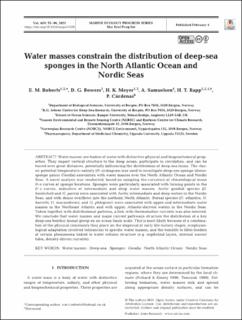| dc.description.abstract | Water masses are bodies of water with distinctive physical and biogeochemical properties. They impart vertical structure to the deep ocean, participate in circulation, and can be traced over great distances, potentially influencing the distributions of deep-sea fauna. The classic potential temperature−salinity (θ−s) diagram was used to investigate deep-sea sponge (demosponge genus Geodia) association with water masses over the North Atlantic Ocean and Nordic Seas. A novel analysis was conducted, based on sampling the curvature of climatological mean θ−s curves at sponge locations. Sponges were particularly associated with turning points in the θ−s curves, indicative of intermediate and deep water masses. Arctic geodiid species (G. hentscheli and G. parva) were associated with Arctic intermediate and deep waters in the Nordic Seas, and with dense overflows into the northern North Atlantic. Boreal species (G. atlantica, G. barretti, G. macandrewii, and G. phlegraei) were associated with upper and intermediate water masses in the Northeast Atlantic and with upper, Atlantic-derived waters in the Nordic Seas. Taken together with distributional patterns, a link with thermohaline currents was also inferred.
We conclude that water masses and major current pathways structure the distribution of a key deep-sea benthic faunal group on an ocean basin scale. This is most likely because of a combination of the physical constraints they place on the dispersal of early life-history stages, ecophysiological adaptation (evolved tolerances) to specific water masses, and the benefits to filter-feeders of certain phenomena linked to water column structure (e.g. nepheloid layers, internal waves/tides, density-driven currents). | en_US |

